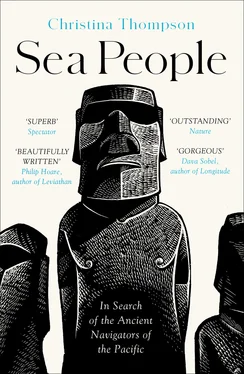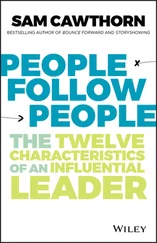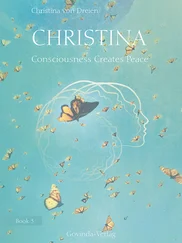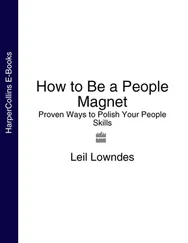This is what is meant by the Polynesian Triangle, an area of ten million square miles in the middle of the Pacific Ocean defined by the three points of Hawai‘i, New Zealand, and Easter Island. All the islands inside this triangle were originally settled by a clearly identifiable group of voyagers: a people with a single language and set of customs, a particular body of myths, a distinctive arsenal of tools and skills, and a “portmanteau biota” of plants and animals that they carried with them wherever they went. They had no knowledge of writing or metal tools—no maps or compasses—and yet they succeeded in colonizing the largest ocean on the planet, occupying every habitable rock between New Guinea and the Galápagos, and establishing what was, until the modern era, the largest single culture area in the world.
FOR MORE THAN a thousand years, Polynesians occupied these islands, and until the arrival of explorers like Captain Cook, they were the only people ever to have lived there. There are not many places on earth about which one can say this, and yet it is true of every island in Polynesia. Until the arrival of European explorers—of Mendaña in the Marquesas and Tasman in New Zealand and Roggeveen on Easter Island—every one of these Polynesian cultures existed in splendid isolation from the rest of the world. This long sequestration is part of what makes Polynesia so fascinating to outsiders—a natural laboratory, some have called it, for the study of language change and genetic diversity and social evolution.
What it means for insiders, on the other hand, is that there exists a great web of interconnectedness that continues to this day. According to New Zealand tradition, Seven, whose real name is Tauwhitu— whitu , or some cognate thereof ( fitu , hitu , itu , hiku ), being the universal word for “seven” in Polynesia—is descended from a voyager named Puhi, who sailed to New Zealand from the ancestral homeland of Hawaiki in one of a fleet of eight great canoes. Whether or not this is really what happened, it is certainly true that his ancestors came to Aotearoa (the Polynesian name for New Zealand) from an island in eastern Polynesia and that their ancestors came to that island from another island before that. The simplicity of this genealogy is stunning. No chaotic mixture of raiders and conquerors; no muddle of Vikings and Normans and Jutes. For centuries Polynesians were the only people in this region of the world, and thus the only people Seven can be descended from are the ones who figured out how to cross thousands of miles of open ocean in double-hulled voyaging canoes.
To me—and not just to me—this is a big part of the fascination with this story. Few of us can trace our own lineages with such certainty going back so far, and it pleases me to think that my children share in this breathtaking genealogy. But what makes the whole thing truly fantastic is what their ancestors had to do in order to find and colonize all of these islands. There is a reason the remote Pacific was the last place on earth to be settled by humans: it was the most difficult, more daunting even than the deserts or the ice. And yet, somehow, Polynesians managed not just to find but to colonize every habitable island in this vast sea.
We know they did it because when the first Europeans arrived in the Pacific, they found these islands inhabited. But we also know that by the time Europeans arrived, the epic phase of Polynesian history—the age of exploration and long-distance voyaging—was already over. The world of the ancient voyagers had blossomed, flourished, and passed away, leaving behind a group of closely related but widely scattered daughter cultures that had been developing in isolation from one another for hundreds of years. Once explorers and migrants, they had become settlers and colonists; they knew themselves less as Voyagers of the Great Ocean than, as in the Marquesan formulation, Enata Fenua (“People of the Land”). Of course, they were still a sea people, traveling within and in some cases among archipelagoes, taking much of their living from the sea. But at far reaches of the Polynesian Triangle—in New Zealand, Hawai‘i, Easter Island, even the Marquesas—they retained only a mythic sense of having ever come from someplace else.
To Europeans, who had themselves only just begun to master the enormous expanses of the Pacific, and then only at the cost of great suffering and loss of life, the discovery of people on these small and widely scattered islands was a source of wonderment. There seemed to be no obvious explanation for how they had gotten there, and, in the absence of any direct evidence, Europeans had difficulty envisioning a scenario that would explain how a people without writing or metal tools could, in the words of Cook, have “spread themselves over all the isles in this Vast Ocean.” This conundrum, which came to be known as “the problem of Polynesian origins,” emerged as one of the great geographical mysteries of mankind.
Over the past three hundred years, all kinds of people have taken a stab at solving this mystery, and many harebrained theories have been proposed: that the islands of Polynesia are the peaks of a drowned continent and the inhabitants the survivors of a great deluge; that Polynesians are Aryans or American Indians or the descendants of a tribe of wandering Jews; that the islands were settled by castaways or fishermen blown thither by capricious winds. But the truth, if you stop to think about it, can hardly be less astonishing; as the New Zealand ethnologist Elsdon Best once put it, “Could the story of the Polynesian voyagers be written in full, then would it be the wonder-story of the world.”
The problem, of course, is that we are talking about prehistory . It is hard enough to know what happened in the past when there exists a documentary record, but there is no written record of these events. Here, the evidence is all partial, ambiguous, open to widely differing interpretations, and in some cases so technical that it is difficult for a layperson to judge. When I first set out to write this book, I imagined I would be recounting the tale of the voyagers themselves, those daring men and women who crossed such stupendous tracts of sea and whose exploits constitute one of the greatest adventures in human history. But, almost immediately, it dawned on me that one could tell such a story only by pretending to know more than can actually be known. This realization quickly led me to another: that the story of the Polynesian settlement of the Pacific is not so much a story about what happened as a story about how we know .
The evidence for what happened in the Pacific has taken different forms in different eras. In the sixteenth, seventeenth, and eighteenth centuries, it consisted of the eyewitness reports of European explorers, who left sketchy but fascinating accounts of Polynesian cultures before they had begun to change under the influence of the outside world. From the nineteenth century we have a different type of source material: Polynesian oral traditions, or what the islanders had to say about themselves. Then, starting in the early twentieth century, science began to deliver up whole new bodies of information based on biometrics, radiocarbon dating, and computer simulations. And, finally, in the 1970s, an experimental voyaging movement emerged, which added a completely different dimension to the story.
Because this evidence is complex—not to mention partial, fragmentary, and perennially open to reinterpretation—the story of what happened in Polynesia has not followed a single bearing to certainty from doubt. In fact, if you were to map it, it would look a lot like the track of a ship under sail, zigzagging and backtracking, haring off in one direction, only to turn and work its way back to an earlier course. There are difficulties with every kind of data—linguistic, archaeological, biological, folkloric—and aspects of the story that have nothing to do with the Pacific at all, for many of the arguments made about Polynesia have been driven by preoccupations originating in Oxford or Berlin.
Читать дальше












